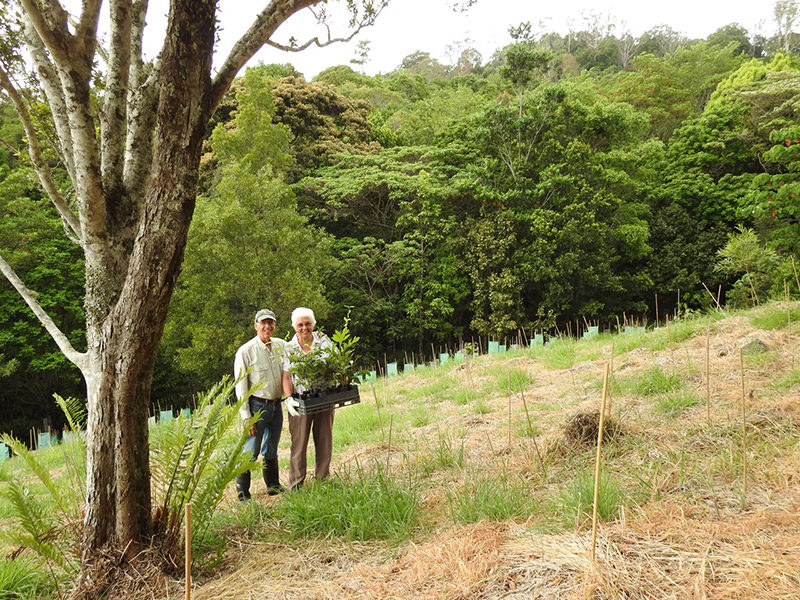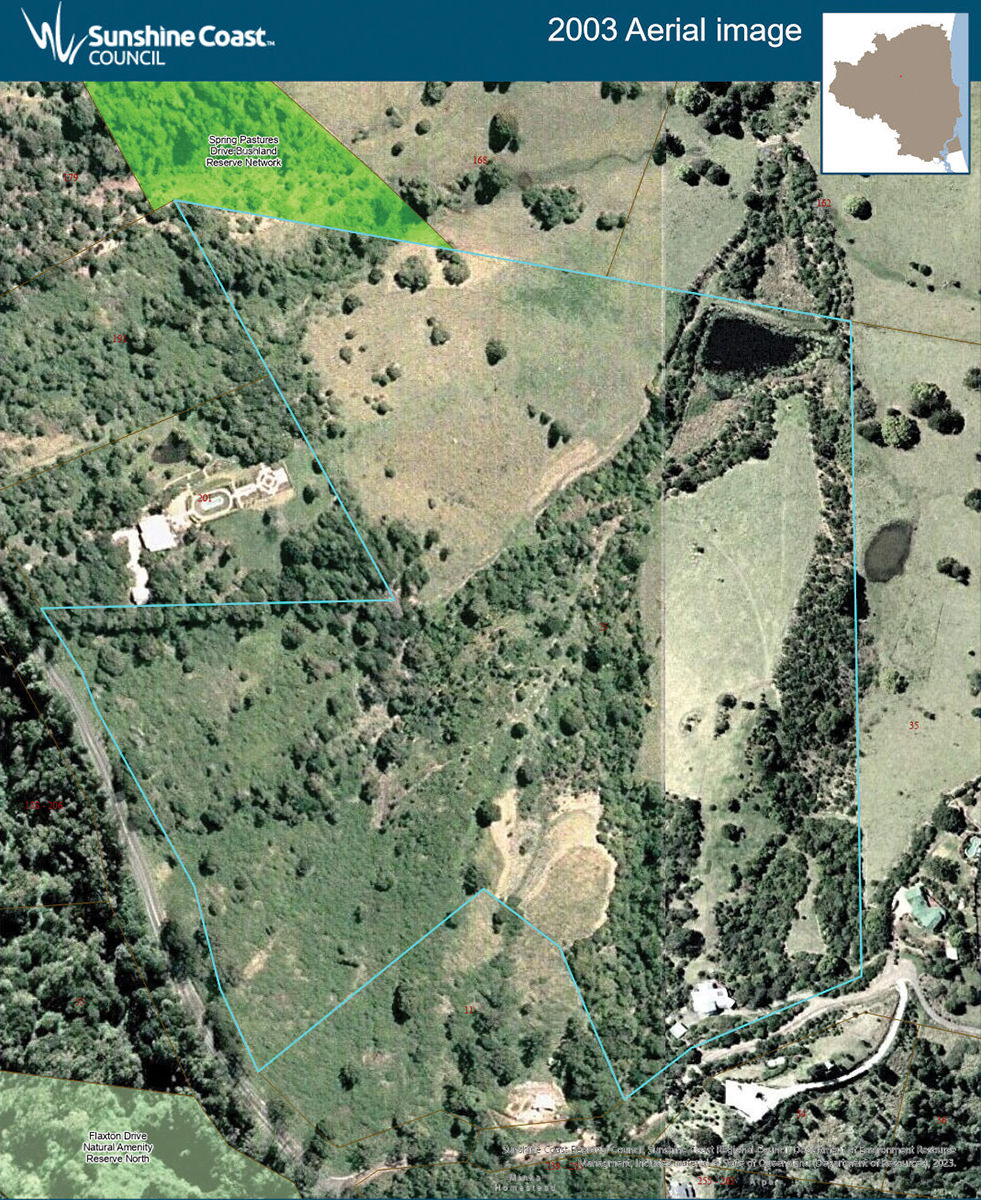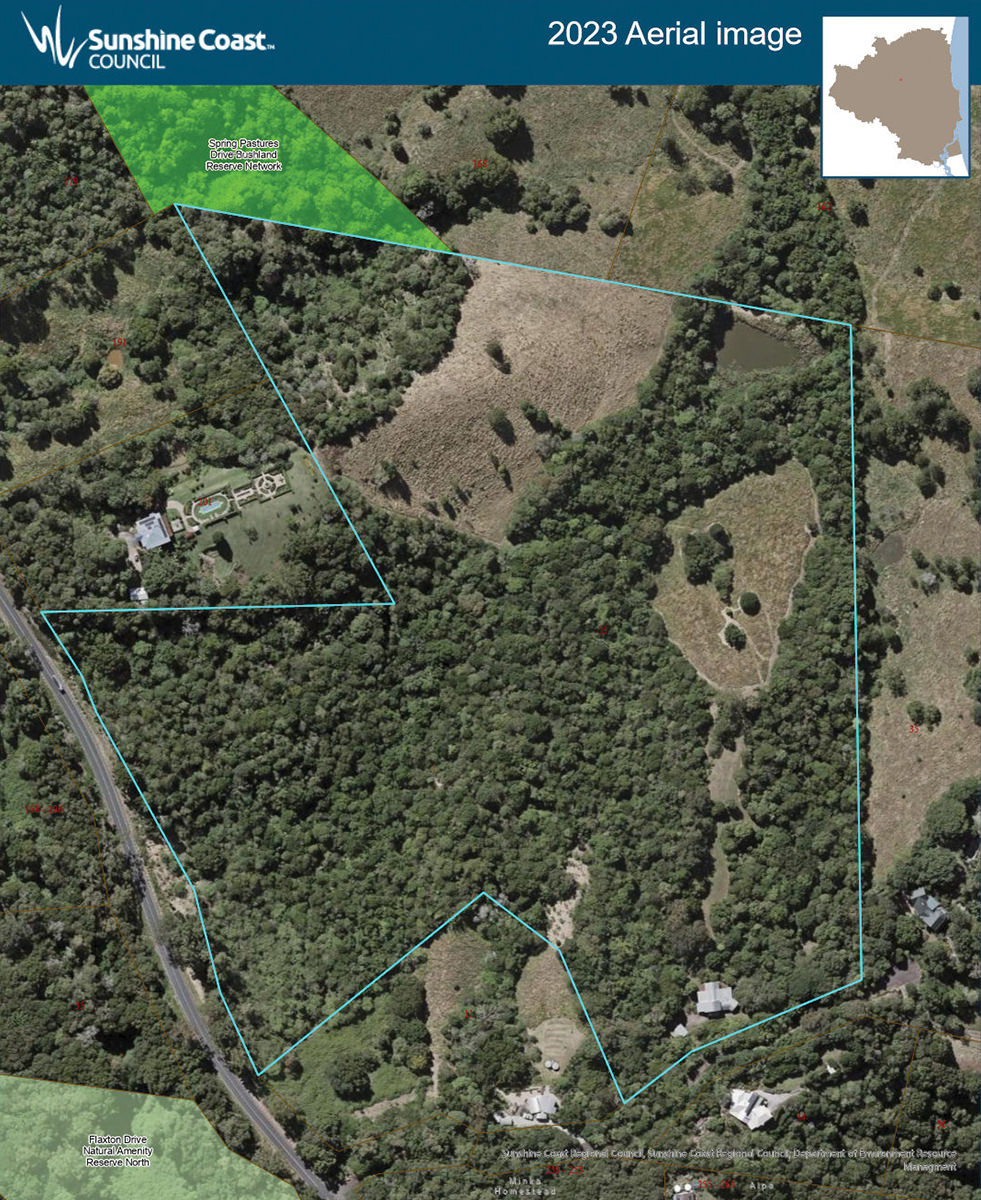Top image caption: This aerial image from 2001 shows the extent of lantana and previously cleared steep areas on Daryl and Craig’s property. The brown areas in the gullies are where Daryl and Craig prepared the site for revegetation.
A question that I occasionally get asked is “how long will it take to restore my property to its natural state”?
This is a tricky question, and one dependent on many factors, for example the extent of damage that has occurred to the original ecosystem. Understanding this and the natural regeneration capacity of the site will determine whether only assisted regeneration such as weed control is required (as the existing ecosystem has the ability to recover naturally), or if a more intensive approach such as planting is needed.
The latter is true for this super couple, who this year, celebrate the 30th year of their property restoration journey. While they continue to extend on planted areas, pull weeds and plan new projects, their goal of providing habitat for a diversity of fauna species happened well before the 30-year mark.
Daryl and Craig moved to their 15.8 hectare Sunshine Coast property in 1994. It was mostly cleared grazing land infested by lantana and heavily compacted by cattle that roamed at will. The property also posed many physical challenges, as it’s positioned on the steep eastern escarpment of the Blackall Range where Echidna Creek starts its journey down to the Maroochy River. Fortunately, the rich soils and favoured hinterland climate facilitated fast plant growth. Daryl and Craig started right away, acquiring knowledge on local vegetation, revegetation techniques and native rainforest plants through Barung Landcare. Joining Land for Wildlife in 1998 gave their efforts another boost.
In 2001, Daryl and Craig partnered with Healthy Waterways and five of their downstream neighbours to plant 18,000 plants, creating a 4 km corridor along Echidna Creek to link up with Spring Pastures Drive Bushland Reserve. Since then, they have been successful in applying for small grants from Sunshine Coast Council and the Federal Government to help employ experienced local bush regenerators to support their work. To ensure the longevity of their efforts, in 2010 they decided to place a Voluntary Conservation Covenant over the vegetation to protect it in perpetuity. In 2018 they added two new covenant areas, expanding the total protected vegetation area to 12 hectares.
The increased diversity of native flora and fauna present is a great performance indicator to show success. Some of the wildlife diversity now found on site include Noisy Pittas, Eastern Whipbirds, Rufous Fantails, Tusked Frogs and possibly Giant Barred Frogs. Topknot Pigeons are now frequent visitors, as are flying foxes.
I often use this project as inspiration to new landholders starting their restoration and land management journey. It’s truly inspiring to witness what can be achieved in a reasonably short period of time. Their outstanding success is not only due to their tireless hard yakka, but the knowledge and lessons learnt early on that guided their planning and restoration processes.
Congratulations Daryl and Craig! Your 30 years of hard work has truly transformed this landscape and has inspired many others to do similar.
KEY TIPS FOR SUCCESSFUL RESTORATION
Select sites strategically to maximise connections and minimise edges.
Linking up or extending on patches of existing vegetation to create larger core areas is important to reducing edge disturbances such as weeds, predators and surrounding land use. In the undergrowth, there are usually more weeds around edges, so smaller forbs and native grasses are likely to thrive in the core area of a larger patch.
Make sure the size of the site is within your ability to maintain for three years.
Developing a restoration plan for the site and breaking the site up into smaller more manageable areas is a great way to record your progress and feel a sense of achievement as you tick off completed areas.
Select species carefully for the specific location.
Use a reference ecosystem near the restoration site with similar environmental conditions such as climate, geology and natural disturbance history to help guide your species selection. Taking note of what is already existing and growing well in your specific location will also help with success.
Use a high ratio of pioneers and fast growers.
The percentage of pioneer species will depend on the site attributes, however a minimum of 30% and maximum of 60% pioneers is recommended. These can be pruned and dropped on the ground to aid in developing a humus layer and to speed up the growth of longer-lived canopy species coming up underneath.
Choose species to seal edges and keep weeds out.
Bushy shrubs and small trees that carry foliage down low are excellent for planting edges and reducing edge effects.
Prepare sites thoroughly, well in advance of planting.
A well-prepared site can speed up site establishment and save time in the long run. Fence the area to exclude livestock, spray out or hand remove exotic grasses and other weeds.
Plant in rows to facilitate maintenance.
Maintenance is fundamental to success. Planting in rows allows for easy access with a mower to keep the grass and weeds down. Within a few years, you won’t even notice the rows. Daryl and Craig cannot use mowers on their steep land, but still advocate planting in rows on contours at regular spacing as a way to help find small seedlings that may otherwise be swamped by rampant weed growth.
Plant closely to achieve quick canopy closure with consequent reduced maintenance.
A tree and shrub spacing of 1.5m centres will result in rapid canopy closure, shading out exotic species and reducing maintenance requirements. Edges can be planted at higher density to reduce edge effects.
Plant early in the wet season to maximise growth.
Planting should preferably be carried out after rain when the soil is moist. Try to avoid seasons where extremes of weather could be expected. February to May is traditionally recognised as a good time to plant in SEQ.
Mulch well to retain soil moisture and control weeds.
If feasible, mulching can be a fantastic addition to your planting site. It helps to reduce competition for light, nutrients, and moisture by suppressing weeds and assisting in water retention to keep roots cool and moist.
References and Further Reading
Chenoweth EPLA and Bushland Restoration Services (2012). South East Queensland Ecological Restoration Framework: Guideline. Prepared on behalf of SEQ Catchments and SEQ Local Governments.
Sunshine Coast Council. Guidelines for Habitat Plantings, Information Sheet.
Article by Nadia Joyce
Land for Wildlife Officer
Sunshine Coast Council


